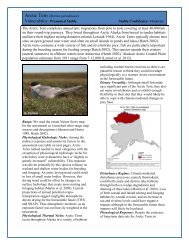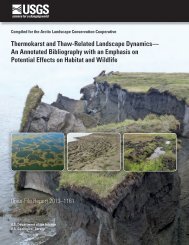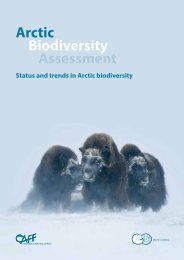Assessing Climate Change Vulnerability of Breeding Birds in Arctic ...
Assessing Climate Change Vulnerability of Breeding Birds in Arctic ...
Assessing Climate Change Vulnerability of Breeding Birds in Arctic ...
You also want an ePaper? Increase the reach of your titles
YUMPU automatically turns print PDFs into web optimized ePapers that Google loves.
Brant (Branta bernicla)<strong>Vulnerability</strong>: Moderately VulnerableConfidence: ModerateThe Brant is a small goose well known <strong>in</strong> Alaska for the tens <strong>of</strong> thousands <strong>of</strong> <strong>in</strong>dividuals thatmolt <strong>in</strong> the Teshekpuk Lake area <strong>of</strong> the coastal pla<strong>in</strong> dur<strong>in</strong>g the late summer. In <strong>Arctic</strong>Alaska, this species typically nests with<strong>in</strong> 8 km <strong>of</strong> the coast although <strong>in</strong> the NationalPetroleum Reserve – Alaska (NPR-A) can nest up to 30 km <strong>in</strong>land (Reed et al. 1998, D.Ward, pers. comm.). Brant <strong>of</strong>ten nest <strong>in</strong> colonies near the upper edge <strong>of</strong> salt marshes alongslop<strong>in</strong>g seacoasts or on estuar<strong>in</strong>e deltas, although <strong>in</strong> areas where salt marshes are lesscommon, they will be more dispersed, nest<strong>in</strong>g near small ponds and freshwater marshes (Reedet al. 1998). Brant subsist on a vegetarian diet and dur<strong>in</strong>g breed<strong>in</strong>g primarily focus on just afew species <strong>of</strong> sedges and grasses (Reed et al. 1998). Alaskan breeders spend their w<strong>in</strong>tersalong the Pacific Coast <strong>of</strong> North America as far down as Baja California (Reed et al 1998).Current Pacific Brant population (which <strong>in</strong>cludes the sizeable Y-K delta breeders) isestimated at approximately 125,000 (<strong>Arctic</strong> Goose Jo<strong>in</strong>t Venture 2008).climate change mitigation (e.g. w<strong>in</strong>d farms) willbe much less pervasive <strong>in</strong> the near future sowould likely only slightly <strong>in</strong>crease vulnerability.S. Zack @ WCSRange: For this assessment, we adjusted theNatureServe Map to more closely reflect therange map depicted <strong>in</strong> the <strong>Birds</strong> <strong>of</strong> NorthAmerica account as the latter more accuratelyrepresented this species’ range based on multipleaccounts and expert op<strong>in</strong>ion (Johnson and Herter1989, Reed et al. 1998, D. Ward, pers. comm.).Sea Level Rise: Because Brant rely on coastalareas for breed<strong>in</strong>g, forag<strong>in</strong>g, and especiallymolt<strong>in</strong>g/stag<strong>in</strong>g <strong>in</strong> the <strong>Arctic</strong> LCC area, theywould most likely be negatively impacted bypredicted sea level rise and a disturbance regime<strong>of</strong> <strong>in</strong>creased storm surge frequency and saltwater <strong>in</strong>trusion (IPCC 2007, Jones et al. 2009).Their ability to shift to nest<strong>in</strong>g habitats that areless susceptible to such phenomena is possibleas they are known to nest further <strong>in</strong>land <strong>in</strong> someplaces, albeit <strong>in</strong> lower numbers than near thecoast (Reed et al. 1998).Human Response to CC: All-weather roads(necessitated by a warm<strong>in</strong>g climate andshortened ice road season) associated withenergy extraction activities could impact Brant,particularly near Teshekpuk Lake, howeverother sources <strong>of</strong> human activity related toPhysiological Hydro Niche: Brant response tochang<strong>in</strong>g hydrological conditions could rangefrom slight to greatly <strong>in</strong>creased vulnerability(see table below) as they are reliant on coastalwetlands that are periodically <strong>in</strong>undated by saltwater and nest<strong>in</strong>g areas could be negativelyimpacted directly through potential tundradry<strong>in</strong>g and <strong>in</strong>directly as some nest predators maybe able to more readily access nest<strong>in</strong>g sitespreviously surrounded by water. Currentprojections <strong>of</strong> annual potential evapotranspirationsuggest negligible atmosphericdrivendry<strong>in</strong>g for the foreseeable future (TWSand SNAP). Thus atmospheric moisture, as anexposure factor (most <strong>in</strong>fluential on the“hydrological niche” sensitivity category), wasnot heavily weighted <strong>in</strong> the assessment.46








